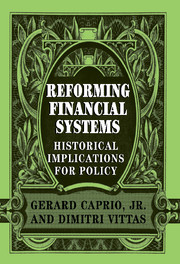Book contents
- Frontmatter
- Contents
- List of contributors
- Foreword
- 1 Financial history: Lessons of the past for reformers of the present
- 2 The evolution of central banking
- 3 Free banking: The Scottish experience as a model for emerging economies
- 4 Regulation and bank stability: Canada and the United States, 1870–1980
- 5 Deposit insurance
- 6 Contingent liability in banking: Useful policy for developing countries?
- 7 Universal banking and the financing of industrial development
- 8 Before main banks: A selective historical overview of Japan's prewar financial system
- 9 Thrift deposit institutions in Europe and the United States
- 10 The development of industrial pensions in the United States during the twentieth century
- 11 The rise of securities markets: What can government do?
- Index
8 - Before main banks: A selective historical overview of Japan's prewar financial system
Published online by Cambridge University Press: 25 March 2010
- Frontmatter
- Contents
- List of contributors
- Foreword
- 1 Financial history: Lessons of the past for reformers of the present
- 2 The evolution of central banking
- 3 Free banking: The Scottish experience as a model for emerging economies
- 4 Regulation and bank stability: Canada and the United States, 1870–1980
- 5 Deposit insurance
- 6 Contingent liability in banking: Useful policy for developing countries?
- 7 Universal banking and the financing of industrial development
- 8 Before main banks: A selective historical overview of Japan's prewar financial system
- 9 Thrift deposit institutions in Europe and the United States
- 10 The development of industrial pensions in the United States during the twentieth century
- 11 The rise of securities markets: What can government do?
- Index
Summary
The postwar experience of the Japanese banking system and its relevance to developing and transition economies has been receiving considerable attention recently. This research has been motivated in part by the fact that the conditions in the defeated Japan of 1945 were similar to those in transition economies today, conditions such as high inflation and the need to switch from military to civilian production.
At the same time many of the postwar conditions in Japan were different from those faced by transition economies today. Before World War II, Japan had spent more than sixty years experimenting with and developing modern financial institutions. This chapter relates some highlights of that history, concentrating on the banks that sprang up from the large industrial conglomerates – zaibatsu.
How did the zaibatsu banks, the predecessors of the main banks of the postwar era, perform? They performed very well relative to their competitors and much differently relative to their postwar successors. Looking at the prewar setting also permits an exploration of banking stability. While the postwar Japanese system was free of major bank failures until 1995, the prewar banking system experienced numerous banking panics and failures, even among zaibatsu banks.
The main bank system and important supplements
Theoretically, the main bank system refers to a network of bank–firm relationships in which most large firms have a main bank. The main bank can be identified by three principal qualities. Typically, it is the largest lender to a particular client, making between 15 and 25 percent of the loans to that client, possibly more to many small companies.
- Type
- Chapter
- Information
- Reforming Financial SystemsHistorical Implications for Policy, pp. 128 - 140Publisher: Cambridge University PressPrint publication year: 1997



